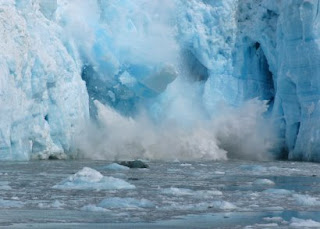Global warming is the increase in the average temperature of the Earth's near-surface air and the oceans since the mid-twentieth century and its projected continuation. Global surface temperature increased 0.74 ± 0.18 °C (1.33 ± 0.32 °F) during the 100 years ending in 2005. The Intergovernmental Panel on Climate Change (IPCC) concludes that anthropogenic greenhouse gases are responsible for most of the observed temperature increase since the middle of the twentieth century,and natural phenomena such as solar variation and volcanoes probably had a small warming effect from pre-industrial times to 1950 and a small cooling effect from 1950 onward. These basic conclusions have been endorsed by more than 40 scientific societies and academies of science, including all of the national academies of science of the major industrialized countries. Global warming is also known as "The Green House Effect" (The Green House Effect causes the global warming).
THE EFFECTS!
Ocean warming, sea-level rise and coastal flooding
 |
Warmer temperatures increase melting of mountain glaciers, increase ocean heat content, and cause ocean water to expand. Largely as a result of these effects, global sea level has risen 4 to 10 inches (10-25 cm) over the past 100 years. With additional warming, sea level is projected to rise from half a foot to 3 feet (15-92 cm) more during the next 100 years. On average, 50 to 100 feet (15-30 meters) of beach are lost for every foot (0.3 meters) of sea-level rise. Local land subsidence (sinking) and/or uplift due to geologic forces and coastal development will also affect the rate of coastal land loss.
Glaciers melting
 |
Over the past 150 years, the majority of mountain glaciers monitored have been shrinking. Many glaciers at lower latitudes are now disappearing, and scientists predict that, under some plausible warming scenarios, the majority of glaciers will be gone by the year 2100. As glaciers continue to shrink, summer water flows will drop sharply, disrupting an important source of water for irrigation and power in many areas that rely on mountain watersheds.
Arctic and Antarctic warming
 |
Parts of Canada, Alaska, Siberia, and the Antarctic have been experiencing warming well above the global average for the past few decades. This trend fits climate model predictions for a world with increasing levels of greenhouse gases. Melting permafrost is forcing the reconstruction of roads, airports, and buildings and is increasing erosion and the frequency of landslides. Reduced sea ice and ice shelves, changes in snowfall, and pest infestations have affected native plants and animals that provide food and resources to many people.
PLEASE, STOP DESTROYING FUTURE!


















